| Air conditioning service station -VAS 6007A- (and further service stations currently available) |

WARNING | t
| It is recommended that a bottle containing water be kept at hand for rinsing out the eyes. |
| t
| Should liquid refrigerant get into the eyes, thoroughly rinse the eyes with water for about 15 minutes. Then administer eye drops and visit a doctor immediately even if the eyes do not hurt. |
| t
| The doctor must be informed that the frostbite has been caused by refrigerant R134a. If, in spite of these safety measures, refrigerant comes into contact with other body parts, these areas must also be immediately rinse with cold water for at least 15 minutes. |
| t
| Work on the air conditioning system refrigerant circuit in well ventilated rooms only. Switch on exhaust gas fume extractor (if there is one). |
| t
| Refrigerant must not be stored in low-lying rooms (e.g. cellars) or their stairways or window shafts. |
|
| l
| Do not weld, braze or soft-solder any parts of the charged air conditioning system. This also applies to welding and soldering work on the vehicle when the danger exists that parts of the air conditioning system may heat up. During painting operations, temperatures of objects in the drying oven or in its pre-heating zone must not exceed 80° C. |
| Heating causes great excess pressure to develop in the system, which can cause the pressure release valve of the system to open. |
| –
| Use the air conditioner service station to evacuate the refrigerant circuit. |

Note | Damaged or leaking components of the air conditioning system must not be repaired by welding or soldering. They must always be renewed. |
| Refrigerant containers (e.g. charging cylinders of air conditioner service station) must never be subjected to excessive heat or exposed to direct sunlight. |
| –
| Never charge a container completely with liquid refrigerant. Without sufficient expansion space (gas cushion), the container will burst should the temperature rise, with devastating consequences → Chapter. |
| Under no circumstances may refrigerant be charged into systems or vessels containing air. |
| –
| Evacuate systems and containers before charging with refrigerant. |
|
|

|
 Note
Note
 Note
Note